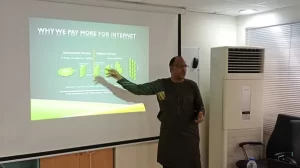Every year, hundreds of thousands of people visit the Shrine of Fatima, roughly 125 km north of Lisbon, Portugal. But, the popular pilgrim site was inaccessible to blind or visually impaired visitors – so they decided to put up braille information signs at points of interest for blind people to enjoy the site.
But this presented a problem.
“There could be a lot of information on the sign in braille… but it is impossible for blind people to find that sign in such a huge place,” Pedro Almeida, COO of iKi Technologies, told ITU News.
Recognizing this issue, iKi Technologies developed an innovative solution to give blind and visually impaired tourists a different way of navigating the site.
The Shrine of Fatima MyEyes mobile application helps blind people independently navigate the site and provides audio descriptions of the spaces and places around them.
“Instead of having this sign for the blind, we have a message automatically in the smartphone,” says Almeida. “When they pass in some area, the smartphone sends them an audio message.”
A necessary app
Navigating unfamiliar environments can be a challenge for the at least 2.2 billion people who are blind or have a vision impairment around the world.
The MyEyes app aims to make cities and spaces more inclusive for people with visual impairments and they can be customized to suit the needs of different locations, sharing useful information such as the location of public bathrooms.
How does it work?
Using the phone’s Bluetooth connection and GPS location data, the app helps visually impaired people navigate both internal and external spaces.
Points of interest, potential hazards and other pieces of useful information around the city are mapped and logged by a local team from MyEyes. These GPS coordinates are then stored in the cloud along with any relevant information – for example, the number of stairs leading to the police station or the opening hours of the restaurant. When a smartphone using the MyEyes app reaches one of these areas, the app pulls the relevant message from the cloud and these are read out as audio messages on the user’s phone.
A similar method is used for indoor areas, where Bluetooth beacons are placed in areas of interest or hazard. When a user reaches one of these beacons, it automatically sends audio messages to users’ smartphones.
The app is complementary to Google Maps, says Almeida.
“Google Maps doesn’t tell you that there is a stair there – or to be aware because there are three steps in front of you – and that kind of information for Google Maps is almost impossible right now. So imagine that Google Maps is the macro and the MyEyes is the micro; we can tell you there is a step there, we are passing by a street so be careful of the cars,” said Almeida. “We go into the detail.”
Navigating the streets
The Inclusive Vilamoura app powered by MyEyes recently launched in Vilamoura, one of the top tourism destinations in Portugal. It has 400 messages to help visually impaired and blind users navigate the city.
“We have beacons inside of the public toilet, inside the police station and sites like the municipality building,” Almeida said. “We can tell [the users] the time schedule for shops and for pharmacies, so we can tell them all the message that the Google Maps can.”
“I think the application is extremely well built and has a lot of information. This [app], for those who do not see, is indeed very important,” said Ana Sofia Antunes, Portugal’s Secretary of State of Inclusion of Persons with Disabilities, in a video interview. “It is a market that exists for companies to invest effectively, because there are more and more people who will need these kinds of technologies.”
Other apps
MyEyes is not the only app available to help visually impaired people.
Using technology to help people with visual impairments is not new: the technology behind voice assistants like Siri and Google Assistant have origins in the 1980s when researchers tried to open computing to persons with disabilities using text-to-speech.
Source of Article
